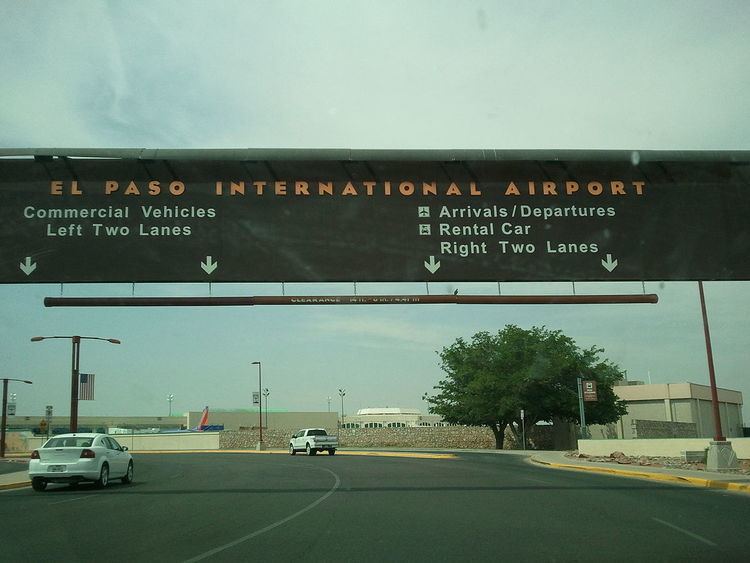Airport type Public Code ELP Phone +1 915-780-4749 | Owner City of El Paso Elevation AMSL 3,958 ft / 1,206 m Elevation 1,206 m | |
 | ||
Operator El Paso Aviation Department Address 6701 Convair Rd, El Paso, TX 79925, USA Profiles | ||
American airlines md 80 landing at el paso international airport n971tw
El Paso International Airport (IATA: ELP, ICAO: KELP, FAA LID: ELP) is a public airport four miles (6 km) northeast of downtown El Paso, in El Paso County, Texas, US. It is the largest commercial airport in West Texas, handling 2,778,248 passengers in 2014. The airport serves the El Paso-Las Cruces CSA.
Contents
- American airlines md 80 landing at el paso international airport n971tw
- A drive through the el paso international airport
- History
- Facilities
- Main terminal
- Airlines and destinations
- Accidents and incidents
- References
A drive through the el paso international airport
History
The city of El Paso built the first El Paso Municipal Airport near the east side of the Franklin Mountains in 1928. The airport was closed by 1945 and in more recent times has been home to the Jobe Concrete Products "Planeport" cement factory. In 1934, Varney Speed Lines (now United Airlines) operated at the original El Paso Municipal Airport (now closed). The original El Paso Municipal Airport construction was inspired by a visit from Charles Lindbergh.
What became the present-day El Paso International Airport was built as Standard Airport by Standard Airlines in 1929 for transcontinental air mail service. Standard Airlines became a division of American Airlines in the 1930s. In 1936, American Airlines "swapped" airports with the city of El Paso and El Paso International Airport was born.
During World War II, the airport was a United States Army Air Forces training base. Units which trained at El Paso Army Airfield were:
At the end of the war the airfield was deemed excess by the military and returned to the local government for civil use. The April 1952 C&GS diagram shows runways 4, 8, 12 and 17, each 7001 to 7062 ft long.
El Paso was the last stop of the first hijacking of a jetliner, a Boeing 707 owned by Continental Airlines. Before deregulation in the USA, El Paso was a focus city for Continental but was soon demoted to a standard station in a hub-and-spoke system under Frank Lorenzo. The airline had a pilot base that was closed in 1963 but re-opened in 1977.
Airport diagram for January 1963
The passenger concourses were built in 1971 as part of an expansion that tripled the size of the airport. It was designed by Garland & Hilles
Serving General Aviation at El Paso International Airport, Cutter Aviation established a Fixed-Base Operation in 1982. Cutter Aviation moved to a new facility on Shuttle Columbia Drive in 2006. Atlantic Aviation also serves general aviation at ELP.
Facilities
El Paso International Airport covers 6,670 acres (2,699 ha) and has three runways:
Main terminal
The terminal is a pier-satellite layout. It has a central entrance and the gates branch out east to west on the two concourses. The Airport has East and West Concourses. Gates A1–A4 are located on the West Concourse and Gates B1–B11 is located on the East Concourse. The Airport has a total of 15 gates. There is also a lower and upper level. The gates are located on the upper level and the ticketing, baggage claim, rental car, and main entrance are located on the lower level of the terminal. The meeter/greeter area is located on the lower level just behind the escalators that lead to the Transportation Security Administration (TSA) checkpoint leading to the gates. Major terminal renovations have been made over the past several years, designed and managed by the local architectural firm MNK Architects.
The Airport access road is Convair Road. Convair Road splits into four lanes with the left two lanes reserved for commercial vehicles and the right two lanes utilized for pickup and drop off of passengers. In between the split road there is a waiting area where passengers can wait for commercial vehicles to arrive.
Gates: Generally, these gates are used for the following airlines. Gates A1–A2: American Airlines and American Eagle. Gate B1: Delta Air Lines. Gates B3–B6: Southwest Airlines. Gate B7: American Airlines and American Eagle. Gates B9 and B11: United Airlines and United Express. Gate B10: Alleigant
Food Court: The food court is located between gates B6 and B11. It is currently occupied with Carlos and Mickey's Mexican Express, Pizza Hut Express, Quizno's and Starbucks Coffee.
Airlines and destinations
El Paso International Airport has 15 gates on 2 concourses: Concourse A has gates A1–A4 and Concourse B has gates B1–B11.
